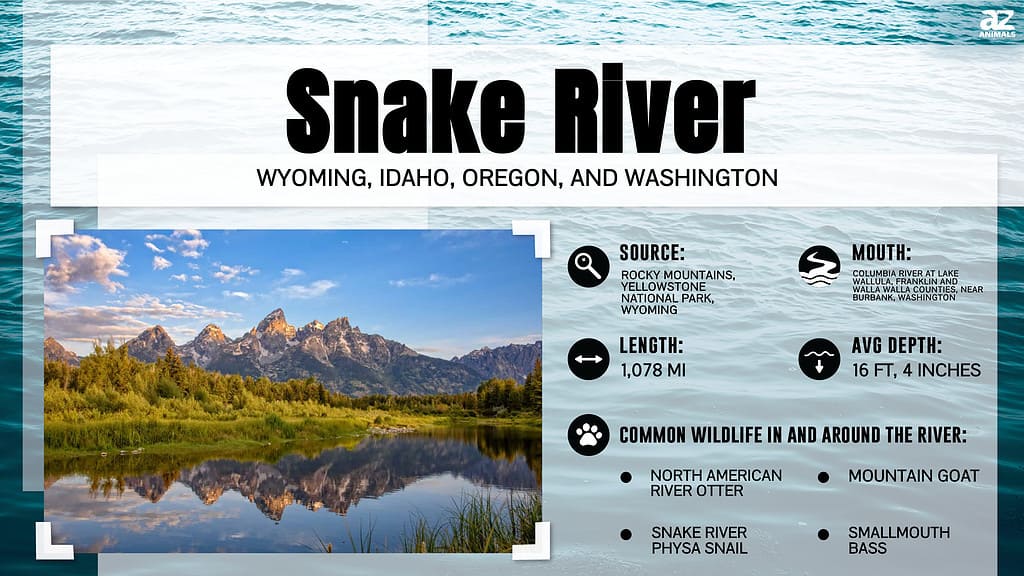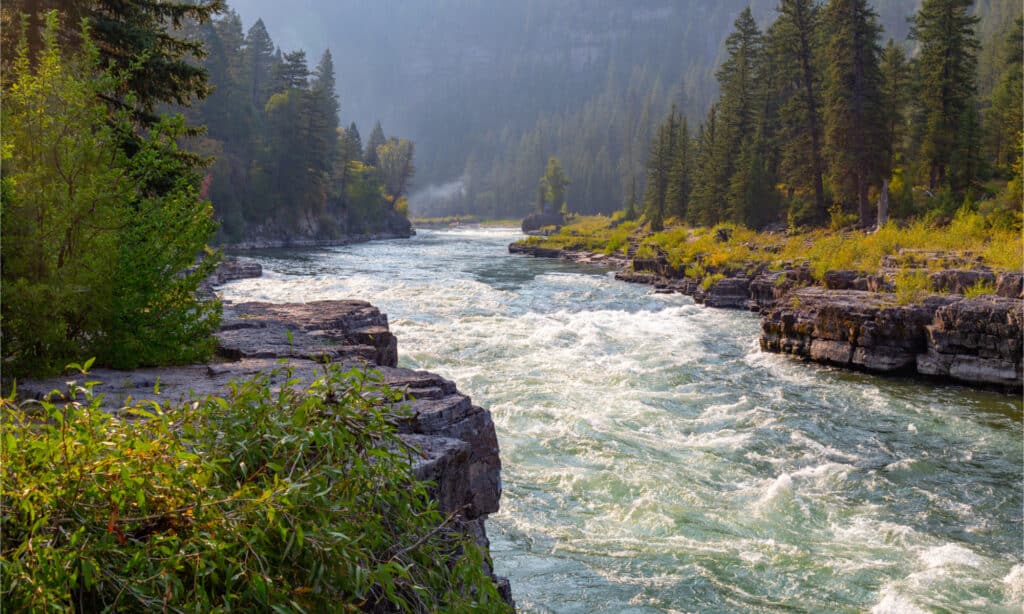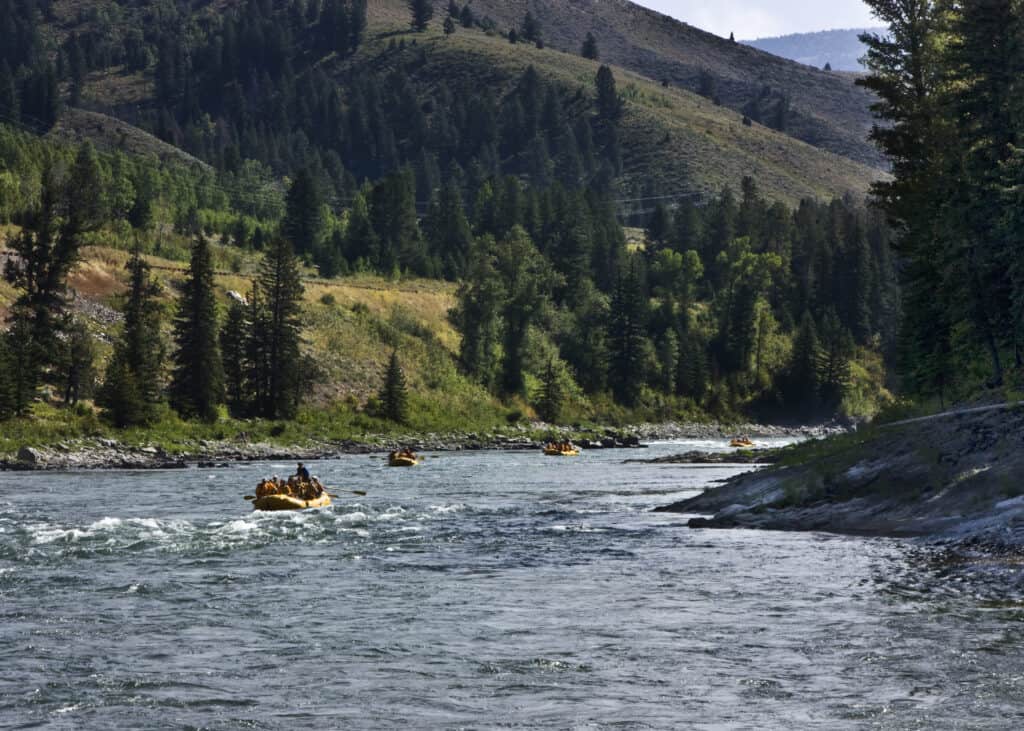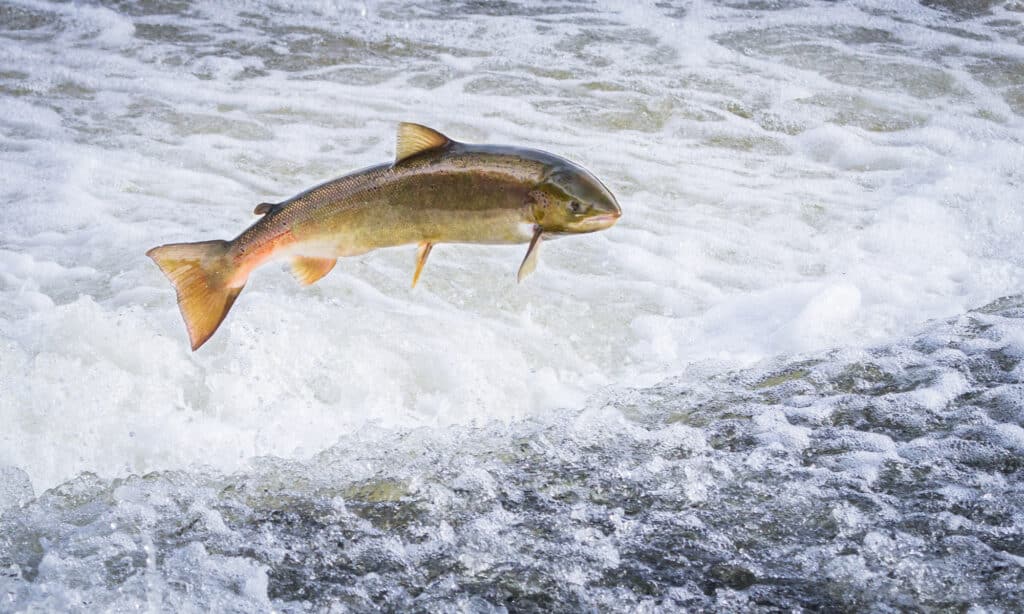Discover the magnificent Snake River, a breathtaking waterway coursing through the American West. Stretching approximately 1,078 miles, it ranks among the region’s longest rivers. Rich in history, it was a vital fur trade route and witnessed Lewis and Clark’s legendary expedition. Today, Snake River continues to mesmerize visitors with its stunning landscapes, vibrant wildlife, and thrilling outdoor pursuits.
From serene fishing spots to exhilarating rafting adventures, let Snake River’s allure captivate your spirit as you immerse yourself in this extraordinary natural treasure. In this article, we’ll get to know every detail of the Snake River firsthand!

History

Stretching approximately 1,078 miles, it ranks among the region’s longest rivers.
©CSNafzger/Shutterstock.com
The Snake River is said to have received its name due to a misunderstanding between European explorers and the Shoshone people. The explorers misinterpreted a hand gesture that resembled swimming and was mistaken for a snake. Hence, the name “Snake River” was given, highlighting the fascinating tale of cultural misinterpretation and the Shoshone’s close association with the abundant river.
This majestic river served as a hub for trade, as noted by early fur traders and explorers, with evidence of ancient trading centers dating back thousands of years.
Located in southeastern Washington, alongside the picturesque Snake River, you’ll find a collection of ancient sites. Among them stands the remarkable Marmes Rockshelter, steeped in history. For an astonishing 11,000 years, this remarkable archaeological site has been bustling with human activity.
Native Americans
Throughout the ages, the Snake River witnessed the rise of two formidable Native American factions asserting their dominance over the region. Expanding their influence from the southeastern Columbia Plateau to western Idaho and northern Oregon, the Nez Perce established their authority as a paramount force. Conversely, the Shoshone claimed ownership over the majestic Shoshone Falls and the expanse of the Snake River Plain, both upstream and downstream.
Lewis and Clark
The remarkable expedition of Lewis and Clark from 1804 to 1806 was an epic journey that crossed the formidable Rocky Mountains. They then ventured down the magnificent Snake and Columbia Rivers, finally reaching the majestic Pacific Ocean.
The U.S. Army Corps of Engineers
During the transformative decades of the 1960s and 1970s, the lower Snake River underwent a remarkable metamorphosis as the U.S. Army Corps of Engineers embarked on an ambitious project. Their mission was to construct not just one but four dams and locks. The primary goal of revolutionizing the region’s shipping capabilities.
Today, it continues to hold importance as a natural and historical treasure, attracting visitors who appreciate its beauty and historical significance.
Size
With a massive length of 1,078 miles, the Snake River goes through a vast expanse of six states: Idaho, Utah, Wyoming, Nevada, Washington, and Oregon. Additionally, the Snake River boasts a basin size of 108,000 square miles.
Boasting an awe-inspiring average discharge of over 54,000 cubic feet per second, the Snake River stands as a remarkable natural wonder. What sets it apart is its distinction as the largest river in North America that gracefully finds its way into the Pacific Ocean.
The river comprises 260.8 miles of wild sections characterized by untamed and untarnished beauty. Along its course, there are also 186.4 miles of scenic areas, which captivate visitors with their picturesque landscapes. Finally, the Snake River offers 33.8 miles of recreational zones, providing opportunities for various water-based activities.
In terms of length, the Snake River ranks as the thirteenth-longest river in the United States.
Depth
On average, the Snake River has been measured to have a depth of approximately 16 feet and 4 inches. In different parts of the Snake River, you will encounter varying depths. Some sections may surprise you with their depth, while others may appear quite shallow. It is important to note that rivers are dynamic bodies of water, constantly changing their depth and shape over time.

The mesmerizing Snake River commences its journey within the picturesque Yellowstone National Park, right by the Continental Divide.
©Tucker James/Shutterstock.com
Source
The mesmerizing Snake River commences its journey within the picturesque Yellowstone National Park, right by the Continental Divide. It gracefully meanders southward, gradually revealing its scenic wonders to all who encounter its path.
Along its way, it passes by the captivating Jackson Lake while embracing the charming town of Jackson. As the river dances through the Snake River Canyon in Wyoming, it transitions into Idaho upon reaching the majestic Palisades Reservoirs. It is here that the river merges with the Henry’s Fork River near Rigby.
Embarking on a remarkable voyage spanning hundreds of miles, the Snake River continues to captivate with its magnificent landscapes until it reaches Pasco, Washington. At this point, the Snake River joins its mighty companion, the Columbia River. The Snake River is the largest tributary of the Columbia River.
Fish
The Snake River, despite being hindered by four enormous dams, manages to sustain an array of native fish species that play a vital role in the ecological well-being of the Western United States. Among these species, Snake River salmon and steelhead undertake one of the longest journeys on Earth.
Salmon and steelhead face a challenging 900-mile swim through a series of dams before they can reach their spawning grounds in Idaho and Wyoming. The river also supports a diverse population of 35 native fish species, including spring and fall Chinook, summer steelhead, west slope cutthroat, red band, and rainbow trout, as well as sturgeon.
Anglers from all over the country hold the South Fork of the Snake River in high esteem. Deeming it one of the best places for trout fishing. This part of the Snake River is home to a diverse range of trout species, including the beautiful, elusive brown trout, the vibrant rainbow trout, and the yellow cutthroat trout.
Hells Canyon
Within the breathtaking Hells Canyon, the wild and scenic stretch of the Snake River provides an exceptional backdrop for pursuing steelhead, sturgeon, trout, and non-native bass.
Unfortunately, fish like salmon and steelhead are unable to access the upper Snake River and its tributaries due to the presence of Hells Canyon Dam.
To maximize your chances of a successful fishing trip on the Snake River, it’s essential to consider the best time of year for specific fish species. For salmon fishing, the months of May to October are optimal. Trout fishing, on the other hand, is most productive during the spring and summer seasons. Finally, if you’re targeting Steelhead, the recommended period is from October to February.

Salmon and steelhead face a challenging 900-mile swim through a series of dams before they can reach their spawning grounds in Idaho and Wyoming.
©Kevin Wells Photography/Shutterstock.com
Geology
Within the expansive western United States, the remarkable Snake River Plain unveils itself. It reveals three distinct sections that shape its captivating landscape: the western, central, and eastern plains.
Dating back approximately 11-12 million years, the western plain emerges as a rift valley adorned with deposits of sediments from ancient lakes. Its foundation boasts a composition of rhyolite and basalt, complemented by a layer of basalt above. Standing at a steep angle in contrast to the central and eastern plains, it bears a resemblance to awe-inspiring volcanic plateaus, such as the renowned Chilcotin Group nestled in the heart of Canada.
Intriguingly, the eastern plain traces a remarkable narrative of the North American Plate’s journey across the powerful Yellowstone hotspot. It proudly showcases basalt formations emanating from shield volcanoes, leaving an indelible mark on the landscape. As it traverses the Basin and Range mountain structures, the eastern plain carves its path in harmony with the dynamic motion of tectonic plates.
The central plain, similar to the eastern one, contains thick layers of sediment from lakes and streams, including the notable Hagerman fossil beds.
Enormous rhyolite ignimbrite eruptions resulted in the formation of the Island Park and Yellowstone Calderas. Henry’s Fork Caldera potentially being the largest symmetrical caldera globally. These eruptions produced massive amounts of ash. The younger volcanic activity covered the plains with basalt lava flows, including the Craters of the Moon National Monument.
The Snake River Plain showcases a variety of geological features, from rift valleys and lake sediments to volcanic plateaus and calderas. Its association with the Yellowstone hotspot and the unique deposition of ash and lava flows contribute to its remarkable geological significance.

The younger volcanic activity covered the plains with basalt lava flows, including the Craters of the Moon National Monument.
©Rui Serra Maia/Shutterstock.com
Activities
From adrenaline-fueled adventures to serene moments of connection with nature, Snake River offers an array of activities that are suitable for all types of travelers and explorers. Whether you enjoy fishing, camping, or hiking, Snake River has something for all.
Camping
Camping at Snake River is a thrilling adventure for outdoor enthusiasts seeking a nature-filled getaway. When it comes to finding the best camping grounds along Snake River, there are several noteworthy options to consider.
One notable campground is Swan Falls Dam Campground, located near the dam. This campground offers picturesque views of the river and surrounding hills, providing a serene atmosphere. It offers basic amenities such as restrooms and picnic tables.
Celebration Park is another popular choice, situated along the Snake River. This campground provides primitive camping options for visitors and is famous for its rich archaeological sites and petroglyphs. It offers a unique and immersive experience for those interested in history and cultural exploration.
For those venturing into Oregon, Farewell Bend State Recreation Area is worth considering. This campground features spacious campsites along the Snake River. The campsites offer amenities such as showers, electricity, and a boat ramp for water activities. It’s an excellent choice for both RV and tent camping enthusiasts.
Traveling to Idaho, Three Island Crossing State Park is a must-visit camping destination. It offers RV and tent camping sites along the Snake River, providing a mix of historical significance and natural beauty. The park holds historical importance as a pioneer crossing site, adding an educational element to your camping experience.
Before embarking on your camping trip, be sure to check availability and make reservations at your desired campground.
Hiking
Snake River is the perfect spot for outdoor enthusiasts with its breathtaking beauty and exhilarating hiking trails. Canyons, waterfalls, and picturesque vistas adorn this diverse landscape, offering a captivating escape into nature.
The beloved Snake River Trail is a remarkable 28-mile out-and-back route near White Bird, Idaho. With a moderate challenge, it’s perfect for backpacking, camping, and hiking, allowing you to immerse yourself in nature. Quiet moments can still be found during off-peak times. The trail is best from March to October, and leashed dogs are welcome.
The 7.3-mile Eureka Wagon Trail, following an old wagon road, rewards hikers with panoramic views of the Snake, Salmon, and Imnaha Rivers. In spring and summer, vibrant wildflowers add color. It’s a blend of natural beauty and cultural heritage.
For awe-inspiring vistas, embark on the 5.3-mile Summit Ridge Trail, situated on the fringes of the Hells Canyon Wilderness. This captivating journey leads to a scenic ridge where you can feast your eyes on panoramic views of the magnificent Snake River. You can also see the Seven Devils Mountains and the neighboring Wallowa Mountains.
Whether a seasoned hiker or nature enthusiast, Snake River’s hiking trails offer an unforgettable adventure amidst stunning landscapes and abundant wildlife.
Boating
Boating at Snake River offers a thrilling experience amidst stunning natural beauty. The river stretches across 6 states, providing ample opportunities for boating enthusiasts.
One of the best spots to explore is Hells Canyon, the deepest river gorge in North America. Its remote and rugged landscape offers an exciting adventure for boaters.
For those seeking a serene boating experience, the Swan Falls Dam in Idaho is a popular choice. It provides calm waters and picturesque surroundings, perfect for a peaceful day on the river. Another notable boating spot is Brownlee Reservoir, situated on the Idaho-Oregon border. This expansive reservoir offers plenty of space for water sports and fishing.
When it comes to boat ramps, Heller Bar on the Washington side is an excellent choice for launching your vessel. It provides access to Hells Canyon and is known for its abundant salmon runs. In Idaho, the Spring Bar boat ramp is a convenient entry point for exploring the Snake River’s breathtaking canyons.
Remember to follow all safety guidelines and obtain necessary permits before embarking on your boating adventure at Snake River.
The photo featured at the top of this post is © Barry Bjork/Shutterstock.com
Thank you for reading! Have some feedback for us? Contact the AZ Animals editorial team.







